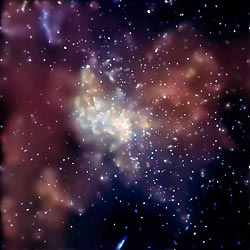
The center of our Milky Way galaxy swarms with gas clouds and millions of stars and is anchored by a supermassive black hole. Only objects that emit X-rays appear in this new image from the Chandra X-ray Observatory satellite. The black hole is embedded in the brightest point at center. Past eruptions at the hole may have blown the lobes of hot gas extending toward upper right and lower left, seen here in red. The frame is 8.4 arcminutes (60 light-years) wide. Click for larger view. Full-resolution images are in a Chandra press release, and an animation is also available.
Courtesy NASA / CXC / MIT / F. K. Baganoff et al.
At the center of the Milky Way galaxy, some 26,000 light-years away in the direction of Sagittarius, lies a black hole with 3 million times the mass of the Sun. The region is a violent one. Interstellar gases and dust spiral toward the hole, causing high-energy eruptions as they descend toward its event horizon. Yet despite these seemingly extreme conditions, our galaxy's black hole is relatively tame.
New observations by the Chandra X-ray Observatory, announced yesterday at the American Astronomical Society meeting in Seattle, show the black hole at the center of the Milky Way, known as Sagittarius A* ("Sagittarius A-star"), to be flaring up almost daily. Frederick K. Baganoff (Massachusetts Institute of Technology) and colleagues used Chandra to image the Milky Way's central few light-years for 164 hours from May 22 to June 4, 2002. They recorded three substantial flares in one 28-hour period, each with 10 times the normal X-ray brightness of the black hole. Numerous other, five-fold brightenings occurred as well.
The nearly constant flares are "unique among supermassive black holes. We couldn't detect them in other galaxies," says Baganoff. Ours is the only galaxy-center black hole close enough for us to witness them. In fact, flares like these may be common in the centers of galaxies everywhere.
Astronomers have long known that the Milky Way's hole is unusually dark and quiet. All types of emissions from it are weak compared to those from many other galactic nuclei. Apparently very little material is falling into it; the Milky Way's belly is being starved. Astronomers continue to speculate on why this is so — perhaps a supernova explosion has cleared the neighborhood of much of its gas, leaving only faint wisps for Sgr A* to snack on just now. Perhaps stellar winds from the many hot, massive stars in the vicinity have blown the gas away. The rate of mass accretion into the gas-starved black hole is currently on the order of only a billionth of a solar mass per year. This puts the observed X-ray flares into perspective — a 10-fold brightening can occur when as little as a cometary mass of material falls into the event horizon. (A comet's solid nucleus is typically only a kilometer or so across.)
Proof of past flares comes from tiny jets that Chandra saw close to the hole. Extending from Sgr A* are a pair of light-year-long X-ray streaks located about 1.5 light-years from the black hole's poles. Their intensity suggests that high flare activity was ongoing for at least several years before the observations.
In addition, Chandra imaged two huge lobes of 20-million-degree gas extending dozens of light-years on either side of Sgr A*. These may have resulted from much more massive eruptions that occurred at the black hole in the more distant past. In fact the eruptions that caused the lobes may be what cleared away the gas to leave the hole starved today.
What we are seeing is the history of flare activity at the hole, says Baganoff; "It takes about 10,000 years for the lobes to reach the location they are at." By comparison the tiny jets represent activity from a couple of years ago, and the flares represent the present.
 0
0
Comments
You must be logged in to post a comment.